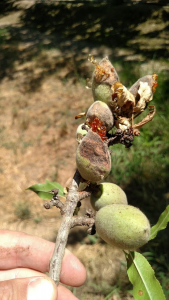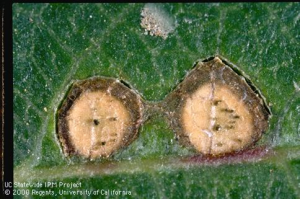Adapted from ‘Winter & Bloom Almond Orchard Management Considerations’ by Katherine Jarvis-Shean and Dani Lightle, published in Sacramento Valley Almond Newsletter, January 2017.
Print off this checklist to make sure you don’t miss any important orchard tasks during almond bloom! Please note that the following are general recommendations intended to help you keep track of regular practices in a busy time; the optimal timing for management practices may vary based on specific location and conditions.
- Mummy nuts should be destroyed by now to reduce over-wintering navel orangeworm (NOW) populations and early generation development sites. If you haven’t been able to get into the orchard because of the rain, try and make completing this task a priority.
- Consider honeybee health and safety for any disease control measures taken during bloom, and follow these bee best management practices.
- If peach twig borer (PTB) was a problem in last year’s harvest, B.t. sprays will provide control with minimal impact on honeybees. This is the only acceptable insecticide for bloom-time application for any insect pest. See the UC IPM guidelines for thresholds and treatment timings.
- Anthracnose management should be considered beginning with bloom timing if weather is warm and rainy when there is a previous history of this disease. UC IPM provides management guidelines.

Sunken orange lesions are a characteristic sign of anthracnose infection on developing almonds. Photo credit: D. Lightle
- Brown rot occurs with warm rainy weather. Flowers are susceptible from pink bud until petal fall, but most susceptible when fully open. Management guidelines differ depending on rainfall.
- Extended wet, cool weather during full bloom into petal fall can lead to green fruit rot. If these conditions are forecast, select fungicide(s) for full bloom application that controls this problem (caused by up to three organisms). Note: FRAC Group 3 fungicides do not provide good, consistent control of green fruit rot.
- If shot-hole fruiting bodies were found in the orchard in fall 2016, select a fungicide with shot-hole activity for a petal fall 2017 application. If no fruiting bodies were found in the orchard last fall, there is no need to spray for shot-hole unless disease symptoms (fruiting bodies) are found on new leaves after bloom.

The small black spots in these shot-hole lesions are the fruiting bodies that indicate treatment may be necessary.
- If scab or rust was a problem last season, monitoring should begin about two weeks after petal fall. Overwintering scab twig lesions typically begin to sporulate in April. If subsequent rain is expected, initiate control.
- Hang San Jose Scale pheromone traps during the last week of February.
- Remove or mow weeds and cover crops before bloom to aid in frost protection.


Leave a Reply